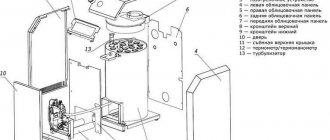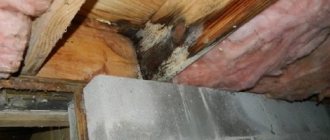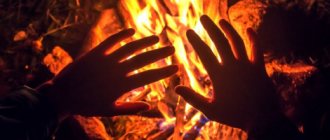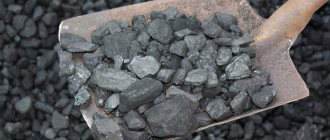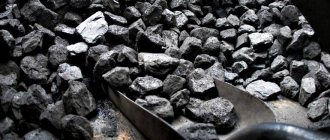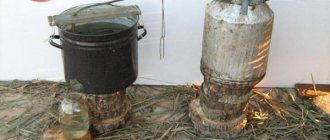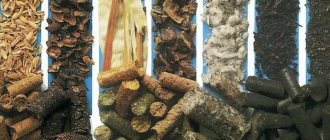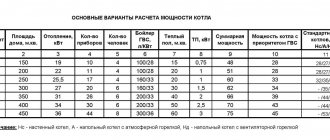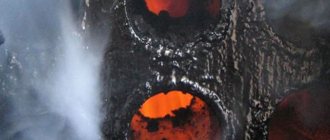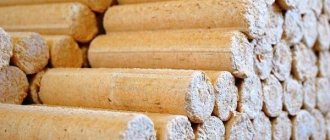Features of different types of fuel
Let's consider the two main, most common types of solid fuel raw materials - firewood and coal. Firewood contains a significant amount of moisture, so the moisture first evaporates, which will require a certain amount of energy. After the moisture evaporates, intense combustion of the wood begins, but, unfortunately, the process does not last long.
Therefore, to maintain it, regular addition of firewood to the firebox is required. The ignition temperature of wood is about 300°C.
In terms of the amount of heat generated and the duration of combustion, coal is superior to wood . Depending on the age of the fossil material, the mineral is divided into types:
- brown;
- stone;
- anthracite.
Types of coal
There are several types of this fuel; the temperature of coal during combustion will be different for each type. Based on their origin, they distinguish between coal obtained from wood and fossil specimens.
Fossil fuels were created by nature itself. It consists of plant components that have undergone changes while located under the thickness of the earth.
The following types of coal fall into this category::
- anthracite;
- brown;
- stone.
There are 3 types of coal
Natural resources
The youngest type of fossil is brown coal. This type of fuel consists of a large number of impurities and has a high level of moisture (up to 40%). In this case, the carbon content can reach up to 70%.
Due to high humidity, this coal has a low combustion temperature and low heat transfer . The combustion temperature is 1900 degrees, and combustion occurs at 250 degrees. The brown variety is rarely used for stoves in private homes, since it is much inferior in quality to firewood.
However, brown coal in the form of briquettes is in high demand. This coolant undergoes special modification. Its humidity decreases, and therefore the fuel becomes more efficient.
This coal has high humidity.
Stone minerals are older than brown ones. In nature they are found very deep underground. This coolant can contain up to 95% carbon and up to 30% volatile impurities. At the same time, the fossil has a low moisture content - a maximum of 12%.
While in the furnace, the combustion temperature of coal is 1000 degrees , and under ideal conditions it can reach 2100 degrees. It is quite difficult to ignite; to do this, you need to heat the fossil to 400 degrees. Stone coolant is the most popular type of fuel for heating buildings and private homes.
Anthracite is the oldest fossil, practically free of impurities and moisture. The amount of carbon in the fuel is more than 95%. The combustion temperature is 2250 degrees under suitable conditions. For ignition it is necessary to create a temperature of at least 600 degrees. It is necessary to use firewood in order to create the necessary heating.
Interesting: the temperature of burning wood in the stove.
This coal has no moisture
Production products
Charcoal is not a natural resource, so it is classified in a separate category. This product is obtained by processing wood. Excess moisture is removed from it and the structure is changed. When properly stored, the moisture content of wood fuel is 15%.
In order for the fuel to ignite, it must be heated to 200 degrees. It should be taken into account that the combustion temperature of charcoal may differ depending on the conditions and type of wood, for example :
- Birch coals are suitable for forging metal - with a high-quality air supply, they will burn at 1200-1300 degrees;
- in a heating boiler or stove, the temperature of charcoal during combustion will be 800-900 degrees;
- in a barbecue outdoors the indicator will be 700 degrees.
Fuel obtained from wood is very economical. It requires much less than firewood. This industrial product is ideal for cooking meat on the grill.
In this video you will learn the difference between coal and charcoal:
GOST 7657-84 Charcoal. Specifications
1 file 106.78 KB Download
Origin of coal
The mineral began to form long before the appearance of man. Approximate age: 400–200 million years. Until now, scientists do not have a clear opinion regarding which plant group formed the coal deposits. Most believe that they are fern-like.
There are 4 main theories trying to explain how coal was formed:
- The most common is the formation of peat, and then coal, due to the decay of ferns, mosses, and horsetails. However, this theory cannot explain fossil layers 400–700 meters thick. After all, to form 500 meters of fossils, 2000 meters of peat are required, i.e. plants of the same species had to grow on the territory for millions of years without changes in weather conditions.
- Thermal theory - slow smoldering of plant residues in an environment with a low oxygen content with gradual transformation into ordinary coal, and then into stone. However, plant parts would not be preserved inside the fossils.
- Sea water version. Having fallen into the ocean, the plants underwent a long process of carbonization, being under pressure and without oxygen. The theory is confirmed by marine finds - algae, sand.
- Abiogenic - coal appeared by heating methane in the presence of hydrogen and carbon dioxide. According to this theory, the finds in the layers are not the remains of plants, but pyrolytic graphite, therefore it is impossible to reliably determine the age of the mined minerals.
When mining and processing mineral deposits, surprising discoveries are sometimes encountered:
- vertical tree trunks;
- huge stone blocks weighing up to 73 kg, of metamorphic or volcanic origin;
- products made of gold and metal, which indicates the ongoing process of coal formation;
- mollusks, shells, annelids;
- round objects resembling dinosaur eggs.
Because of its origin, coal is called canned solar energy - plants are able to accumulate it in leaves and shoots.
What is coal made of? What is the chemical formula of coal
Coal is one of the oldest fuels known to man. And even today it occupies a leading position in terms of volume of use. The reason for this is its prevalence, ease of extraction, processing and use. But what is he? What is the chemical formula of coal?
In fact, this question is not entirely correct. Coal is not a substance, it is a mixture of different substances. There are a lot of them, so it is impossible to completely determine the composition of coal. Therefore, by the chemical formula of coal in this article we will rather mean its elemental composition and some other features.
But what can we learn about the state of this substance? Coal is formed from plant remains over many years due to exposure to high temperature and pressure. And since plants are organic in nature, organic substances will predominate in the composition of coal.
Depending on the age and other conditions of origin of coal, it is divided into several types. Each type differs in its elementary composition, the presence of impurities and other important characteristics.
Brown coal
It is the youngest type of coal. It even exhibits a plant-like woody structure. It is formed directly from peat at a depth of about 1 kilometer.
This type of coal contains a fairly large amount of moisture: from 20 to 40%. When exposed to air, it evaporates and the coal crumbles into powder. Next we will talk about the chemical composition of this particular dry residue. The amount of inorganic impurities in brown coal is also large and amounts to 20-45%. These impurities include silicon dioxide, aluminum, calcium and iron oxides. It may also contain alkali metal oxides.
This coal contains a lot of volatile organic and inorganic substances. They can make up up to half the mass of this type of coal. The elemental composition excluding inorganic and volatile substances is as follows:
- Carbon 50-75%.
- Oxygen 26-37%.
- Hydrogen 3-5%.
- Nitrogen 0-2%.
- Sulfur 0.5-3%.
Coal
In terms of formation time, this type of coal comes next after brown coal. It has a black or gray-black color, as well as a resinous, sometimes metallic sheen.
The moisture content of hard coal is significantly less than brown coal: only 1-12%. The content of volatile substances in coal varies greatly depending on the location of mining. It can be minimal (from 2%), but can reach values similar to brown coal (up to 48%). The elemental composition is as follows:
- Carbon 75-92%.
- Hydrogen 2.5-5.7%.
- Oxygen 1.5-15%.
- Nitrogen up to 2.7%.
- Sulfur 0-4%.
From this we can conclude that the chemical formula of hard coal consists of more carbon than that of brown coal. This makes this type of coal a higher quality fuel.
Physico-chemical properties of stone
The main element of stone is carbon, which is why it burns well and for a long time. In addition, it contains water. The ratio of elements depends on the age of the mineral:
| Coal name | % water | % carbon | % volatile matter | How does it ignite? | How it burns | Heat dissipation |
| Brown | Up to 43 | Up to 45 | Up to 50 | Fine | Fine | Low |
| Stone | Up to 12 | 75–95 | Up to 32 | Great | Fine | Average |
| Anthracite | 1–3 | 85–95 | Less than 9 | With difficulties | Weak, no smoke due to low volume of volatile impurities | High |
Properties:
- specific gravity – 1.5–1.7 g/cm2;
- combustion temperature in the furnace – 700–1100 °C;
- shine – pronounced, with a metallic tint, less often – golden;
- specific heat capacity – 1300 J/(kg × K);
- specific heat of combustion – 5700 kcal/kg;
- fracture – uneven, conchoidal;
- hardness of coal ash on the Mohs scale – 2;
- The shelf life of coal is 6–18 months.
Watch a program where a scientist talks in an entertaining way about the properties of the mineral:
Production process technology
In ancient times, people used charcoal technology to produce coal fuel. They placed firewood in special pits and covered them with earth, leaving small holes. After the industrial revolution, the charcoal charring procedure began to be carried out using automated equipment capable of controlling the carbonization reactions of substances and heating the material to combustion temperature.
In industrial conditions, this material is produced in small quantities. Before producing charcoal, you need to choose the right raw materials, purchase specialized equipment and determine the manufacturing technology. The industry uses 3 main methods for producing charcoal:
- drying;
- pyrolysis;
- calcination
The resulting products are packaged in bags, briquetted and labeled. GOST 7657-84 describes how charcoal is made in production. It describes the process flow diagrams and provides precise information about the amount of temperature required to heat the raw materials.
Charcoal can be produced at home, forming a cottage industry. Most often, a personal plot is chosen as a place for the production of these raw materials. Before making charcoal, you need to arrange the premises in accordance with safety rules, choose a manufacturing technology and evaluate the prospects for the development of a business project.
Selection of raw materials
According to GOST 24260-80 “Raw materials for pyrolysis and charcoalization”, when creating charcoal, hardwood is required. This group includes birch, ash, beech, maple, elm and oak. Coniferous trees are also used in production: spruce, pine, fir, larch and cedar. The least used softwoods are pear, apple, plum and poplar.
GOST 24260-80 Wood raw materials for pyrolysis and charcoalization. Specifications
The raw materials must have the following dimensions: thickness - up to 18 cm, length - up to 125 cm. The wood should not have a large amount of sap rot (up to 3% of the total area of the workpiece). Its presence reduces the hardness of the material and increases its ash content. Large amounts of water are not allowed. This substance leads to the appearance of cracks on the surface of the workpieces.
Drying wood
During the drying process, the raw materials are placed in a charcoal burning block. Wood is affected by flue gas. As a result of heat treatment, the temperature of the workpieces increases to 160 °C. The amount of water contained in wood affects the duration of the technological process. As a result of drying, a material with a moisture level of 4-5% is obtained.
Pyrolysis
Pyrolysis is a chemical decomposition reaction that involves heating a substance with a lack of oxygen. During combustion, dry distillation of wood occurs. The workpieces are heated to 300 °C. Pyrolysis removes H2O from the raw material, which leads to charring of the material. With further heat treatment, the wood is converted into fuel, the percentage of carbon is 75%.
Calcination
After pyrolysis is completed, the product is calcined. This procedure is necessary to separate resins and unnecessary gases. Calcination occurs at a temperature of 550 °C. After this, the substance is cooled to 80 °C. Cooling is necessary to prevent the product from spontaneous combustion upon contact with oxygen.
Charcoal
This type of coal is not a fossil, so it has some peculiarities in its composition. It is produced by heating dry wood to a temperature of 450-500 oC without air access. This process is called pyrolysis. During this process, a number of substances are released from the wood: methanol, acetone, acetic acid and others, after which it turns into coal. By the way, burning wood is also pyrolysis, but due to the presence of oxygen in the air, the released gases ignite. This is what determines the presence of flames during combustion.
Wood is not homogeneous; it has a lot of pores and capillaries. A similar structure is partially preserved in the coal obtained from it. For this reason, it has good adsorption capacity and is used along with activated carbon.
The humidity of this type of coal is very small (about 3%), but during long-term storage it absorbs moisture from the air and the percentage of water increases to 7-15%. The content of inorganic impurities and volatile substances is regulated by GOSTs and should be no more than 3% and 20%, respectively. The elemental composition depends on the production technology, and looks approximately like this:
- Carbon 80-92%.
- Oxygen 5-15%.
- Hydrogen 4-5%.
- Nitrogen ~0%.
- Sulfur ~0%.
The chemical formula of charcoal shows that in terms of carbon content it is close to stone, but in addition it has only a small amount of elements unnecessary for combustion (sulfur and nitrogen).
What coal to choose for the fire?
What is coal? This is a product of plant origin, which contains carbons and non-flammable impurities. It is they who form ash and slag-like substances after burning. The ratio of the two components is different everywhere. It is this, as well as the “age” of natural fuel, that determines the grade of coal. Experts distinguish several varieties.
The “youngest” type of coal is lingite. It has a rather loose structure. If you pick up a lump of lingite, it will quickly crumble and lose its shape. This type of coal is most often used in thermal power plants, but lingite is not suitable for heating a home.
In addition to lingite, brown coal, hard coal, and anthracite are also mined - the most ancient carbon deposits. All varieties have different humidity levels. In brown coal, for example, humidity is 50%; in anthracite its threshold does not exceed 7%. Therefore, anthracite has the highest specific heat. Its indicators are 9 thousand kcal/kg.
Material for coal-fired stoves is the main criterion for choosing fuel and stove. Let's look at these qualities in more detail.
When the heating of the stove is successfully completed and the firewood is happily blazing in the firebox, all that remains is to monitor the thermal operating conditions and add new logs in time. As for the mode, it is recommended to maintain it constantly at the same level, avoiding overheating
This is important because alternating intense heating and cooling often causes the furnace body to expand and contract, causing cracks to occur.
Maintaining optimal thermal conditions and timely adding logs is the best way to properly heat a stove with wood, although it is not very convenient at night. No one wants to get up in the middle of the night, although if there is severe frost outside, this cannot be avoided, otherwise the house will be cold by morning. During continuous burning for several days, the ash pan has to be cleaned
Combustion process
Depending on the type and grade, fuel is divided into short-flame and long-flame. Short-flame coals include anthracite and coke, and charcoal.
When burned, anthracite produces a lot of heat, but to ignite it it is necessary to provide a high temperature with a more easily flammable fuel, such as wood. Anthracite does not emit smoke, burns odorless, and has a low flame.
Long-flame fuels burn in two stages. First, volatile gases are released, which burn above the coal layer in the furnace space.
After the gases burn out, the remaining fuel begins to burn, which has meanwhile turned into coke. The coke burns on the grates with a short flame. After carbon burns out, ash and slag remain.
Combustion formulas
Ignition temperatures of different types of fuel (click to enlarge)
When fuel (wood, coal) ignites, a chemical reaction occurs and heat is released.
Carbon dioxide reacts with the carbon in the fuel in the upper layers to form carbon monoxide.
The combustion process does not end there, because rising up in the combustion space, carbon monoxide reacts with oxygen from the air, the influx of which occurs through the vent or the open firebox door.
Its combustion is accompanied by a blue flame and the release of heat. The resulting carbon monoxide (carbon dioxide) enters the chimney and escapes through the pipe.
Smoldering with minimal oxygen will produce non-poisonous carbon monoxide, producing even heat.
Coal combustion - What is the formula for coal combustion? — 22 answers
Coal burning
In the Other Education section, answer the question What is the formula for burning coal? given by the author Maria Nasonova, the best answer is Coal + oxygen and fire = Ayyyyyyy hot!!!
Hello! Here is a selection of topics with answers to your question: What is the formula for burning coal?
Reply from CoBRA79922C+O2—>2CO just like that!!
Answer from Irina Zarechkova Finding out the chemical formula of coal is the same as figuring out the chemical formula of borscht. Coal (coals, they are very different and have different compositions) is a mixture of different chemicals, mainly high molecular weight polycyclic aromatic compounds (arenes) with a high carbon content. Coal is not pure carbon with a crystalline lattice, as many people believe. The most obvious way to think of coal is as solidified oil. After all, oil is also a mixture of hydrocarbons, even with a higher carbon content in relation to coal, but no one claims that oil is liquid carbon in its pure form. Thus, if you are interested in the composition of a specific grade of coal, then look for information on arenes (anthracene C14H10 is one of the largest molecules, consisting of three benzene rings, a large amount of carbon in it is noticeable even from the simplified formula; naphthalene C10H8 - two benzene rings; benzene C6H6 - one benzene ring; as well as their modifications and other variants). In addition to polycyclic hydrocarbons, coals contain varying amounts of water and mineral impurities. Based on hydrocarbon content, coals are divided into brown (65-70% carbon, up to 50% volatiles and about 43% water), hard coal (about 80% carbon, up to 32% volatiles and up to 12% water), anthracite (up to 96% water). carbon, less than 8% volatiles). Anthracite - this ancient, shiny and dense coal, which even gives its name to noble black shades of paint, is already similar to what coal is generally considered to be: pure carbon, well, slightly contaminated with impurities. Anthracites are formed at elevated pressure and temperature at greater depths, therefore their composition is closest to graphite, which is precisely an allotropic modification of carbon in its pure form (with a crystal lattice) and can also be considered coal.
Hello! Here are more topics with the answers you need:
Application
The main use of fuel is to burn it to produce heat. Heat is used not only for heating a private home and cooking, but also in industry to support technological processes that occur at high temperatures.
Unlike a conventional stove, where the process of oxygen supply and combustion intensity is poorly regulated, in industrial stoves special attention is paid to controlling the supply of oxygen and maintaining a uniform combustion temperature.
Let's consider the basic scheme of coal combustion.
- The fuel heats up and moisture evaporates.
- As the temperature rises, the coking process begins with the release of volatile coke gases. When burned, it provides the main heat.
- Coal turns into coke.
- The coke combustion process is accompanied by the release of heat sufficient to initiate coking of the next portion of the fuel.
In industrial boilers, the combustion of coke is separated into different chambers from the combustion of coke oven gas. This allows the flow of oxygen for coke and gas at different intensities, achieving the required combustion rate and maintaining the required temperature.
Maximum coal combustion temperature (video)
Today, this use of a variety of solid fuels, in the form of wood, coal or peat, is popular. It is used not only in everyday life for heating or cooking, but in many industries.
Comments
0 Daniil 02/16/2018 13:06 I never thought about combustion temperature, but in practice anthracite showed itself to be the best.
It burns longer and leaves very little buzz after it, unlike regular coal. As a result, anthracite is more economical, burns well and leaves little waste after it. Quote
Update list of comments RSS feed of comments for this entry
Using Charcoal
In everyday life, charcoal is used to cook meat on the grill.
Thanks to the high combustion temperature (about 700°C) and the absence of flame, uniform heat is provided, sufficient for cooking meat without charring.
It is also used as fuel for fireplaces and cooking on small stoves.
In industry, it is used as a reducing agent in metal production. Charcoal is indispensable in the production of glass, plastics, and aluminum.
It is possible to make charcoal yourself. Details: https://teplo.guru/eko/drevesnyiy-ugol-svoimi-rukami.html
Use of brown coal
Although the combustion temperature and heat transfer of brown fossils is lower than that of stone, it is also used for heating and cooking.
This is due to its low cost.
But brown coal is more widely used for processing and producing various chemicals: semi-coke, rock wax, soot, gasoline.
The operating principle and advantages of coal boilers are discussed here: https://teplo.guru/kotly/tverdotoplivnye/ugolnye-kotly-otopleniya.html
Watch the following video about burning brown coal:
Application of brown coal and charcoal: areas of use
Brown coal is the cheapest among other types of fuel. Therefore, it is widely used in everyday life and some industry. For example, in the chemical industry, for the production of soot, gasoline, semi-coke, mining wax, as well as their processing.
Charcoal, like brown charcoal, is in great demand. It is used in everyday life for frying meat on the grill or grill. This type of fuel is also used for cains or small stoves on which various foods can be cooked.
This fuel has brought very great environmental benefits. Charcoal, today, is considered an environmentally friendly fuel and at the same time completely safe. Therefore, it is widely used in many industries.
Use of this coal in industry:
- In the production of very rare and valuable metals;
- Used in gas masks as a trap for harmful substances;
- Purify gas emissions and wastewater;
- Taken for poisoning in medicine;
- How to feed cattle in agriculture;
- Excellent fertilizer for the soil;
- As a reducing agent.
Charcoal is capable of burning without the formation of ash or flame, while emitting even heat. Its combustion temperature is not always constant, it can vary. Birch coals, for example, can even be used in blacksmithing, as they can reach a combustion temperature of 1200 - 1300 degrees.
Charcoal burning temperature
Regular charcoal, produced by burning dry wood, has surprisingly high performance. Its specific calorific value reaches 7400 kcal/kg, humidity is a maximum of 15% (depending on storage conditions) and the ash content is so low that almost nothing remains after combustion. As for the combustion temperature of birch coals, in practice it is enough to soften and forge metal in a forge. This is approximately 1200-1300 ºС.
This simple type of fuel is also used for cooking on various outdoor stoves. And, although the conditions for burning charcoal in a barbecue are far from ideal, its consumption is much less than that of ordinary firewood. This is due to decent heat generation and the absence of ash inclusions.
Activated carbon
Activated carbon is a type of carbon with a high specific pore surface area, which makes it even more absorbent than wood. The raw materials used for its production are charcoal and coal, as well as coconut shells. The starting material is subjected to an activation process. Its essence is to open clogged pores using high temperature, electrolyte solutions or water vapor.
During the activation process, only the structure of the substance changes, therefore the chemical formula of activated carbon is identical to the composition of the raw materials from which it was made. The moisture content of activated carbon depends on the specific pore surface area and is usually less than 12%.
Source
Final temperature table
| Coal | Temperature | Advantages | Flaws |
| Birch | 600-650°C | Reasonable price, optimal burning time and temperature | Average burning time |
| Briquettes | 650-700°C | Burn for a long time, good heat, minimum smoke | Difficult to light, high price |
| Oak | 620-660°C | Burns long, dense | Difficult to light, high price, rare |
| Pine | 570-620°C | Low price | Burns quickly and smokes |
| Aspen | 570-620°C | Low price | Burns quickly, smokes |
How to store coal
When purchasing a large amount of fuel at once, you need to know how to store it. If you follow storage rules, coal will not lose its original properties.
Shelf life
It is beneficial to purchase solid fuel in large quantities at once. But, like any other combustible material, coal has a shelf life that depends on the deposit and brand.
It is interesting that coal can remain in the bowels of the earth for millions of years without losing its quality. However, once mined, it immediately begins to interact with the environment. The most dangerous thing for it is a meeting with oxygen - that is, oxidation. It destroys the structure of the raw material and renders it unusable.
The larger the coal pieces, the longer it will take to oxidize. For example, coal with a fraction above 100 mm can be stored without loss of quality characteristics for up to 3 years, with pieces with a size of up to 100 mm - about 1 year, and fuel with a fine fraction - less than 24 months. The 20-40 mm fraction, which you can purchase from our company, retains its quality for one season. That is, it makes no sense to store such coal for several winters.
Premises requirements
The ideal storage location is dark, covered and well ventilated. The material can be packaged in bags or wooden boxes. Coal can be placed in the yard. To do this, use a platform into which coal is poured and compacted to reduce the air gap. To extend shelf life, it is advisable to cover the fuel with a lid or polyethylene.
Let's look at a specific example. For the heating season we need 3.5 tons of coal (about 4.5 cubic meters). This means you need a room of 4 m2 and another area for passage. It is advisable that the premises have a reserve area (at least 5% of the area). It will be needed to refresh coal during long-term storage and cooling if it is hot.
It is best if the coal storage room is next to the boiler room. This way you won't have to carry heavy buckets over long distances. It must be equipped with drainage structures to drain melt, rain and groundwater.
The warehouse cannot be equipped with various communications - gas pipelines, heat sources, electrical lines. In addition, it should not be located where underground communications pass - electrical cables, pipelines, and so on.
You should always remember that coal can ignite. That is why this factor must be taken into account during storage. You need to place the fuel, compacting the small pieces well. After all, spontaneous combustion, which occurs due to the penetration of air into the layers of coal, can cause a fire. Spontaneous combustion can occur in places where different types of fuel or different grades of coal come into contact. Also, fresh coal should not be unloaded onto a site that is poorly cleared of old fuel residues.
Storing coal indoors or under a canopy helps preserve the quality characteristics of the fuel for a longer period. But it is not always possible to store it in closed conditions.
Outdoor coal storage
It is best if you find a dry and dark place to store the fuel. This could be a barn, shed or other outbuildings. You can purchase a special bunker - a metal box with a closing hatch. Canvas bags are also suitable (it will be more convenient to transport coal to the boiler in them).
It’s not scary if the coal is stored in the open air. As for precipitation, it is not harmful to fuel. But in order for coal not to lose its properties, you need to follow several recommendations for storing the material.
So, if you are forced to store coal outside:
- Choose a flat, debris-free area for the material. It must be located in a non-flooded, somewhat elevated place (so that during spring floods or rainy times the water does not wet the coal from below). The soil under the material must be dry or frozen.
- It is desirable that the base under the coal be solid. You can lay it out with bricks, tiles, and finally lay down boards or lay wooden pallets.
- When choosing a site, make sure that there are no open sources of fire nearby or expected. Also make sure that there is no equipment that operates at high temperatures (for example, welding) near the coal.
- Before adding material to the site, place a tarp underneath it. This way the coal will be dry, without snow and leaves.
- Periodically pour and stir the material (especially during frosts). This is necessary to ensure that the coal does not freeze in the open air.
As you can see, this material is quite demanding in terms of storage conditions. However, this is compensated by its high efficiency.
Coal: varieties and characteristics
Coals primarily differ in origin. Charcoal, which is obtained by burning wood, as well as fossil fuels are used as an energy source.
Fossil coals are fuels created by nature. They consist of the remains of ancient plants and bitumen masses, which underwent a number of transformations in the process of sinking underground to great depths. The transformation of starting substances into effective fuel took place at high temperatures and in conditions of oxygen deficiency under the earth. Fossil fuels include brown and hard coals, as well as anthracite.
Brown coals
Among fossil coals, the youngest are brown coals. The fuel got its name from its brown color. This type of fuel is characterized by a large amount of volatile impurities and high moisture content - up to 40%. In this case, the amount of pure carbon can reach 70%.
Due to high humidity, brown coal has a low combustion temperature and low heat transfer. Fuel ignites at 250°C, and the combustion temperature of brown coal reaches 1900°C. The calorific value is approximately 3600 kcal/kg.
As an energy carrier, brown coal in its natural form is inferior to firewood, so it is rarely used for stoves and solid fuel units in private homes. But briquetted fuel is in steady demand.
Brown coals
Brown coal in briquettes is a fuel that has undergone special preparation. By reducing humidity, its energy efficiency increases. The heat transfer of briquetted fuel reaches 5000 kcal/kg.
Stone coals
Hard coals are older than brown coals; their deposits are located at a depth of up to 3 km. In this type of fuel, the content of pure carbon can reach 95%, and volatile impurities - up to 30%. This energy carrier contains no more than 12% moisture, which has a positive effect on the thermal efficiency of the mineral.
The combustion temperature of coal under ideal conditions reaches 2100°C, but in a heating furnace the fuel is burned at a maximum of 1000°C. The heat transfer of coal fuel is 7000 kcal/kg. It is more difficult to ignite - it requires heating up to 400°C to ignite.
Coal energy is most often used to heat residential buildings and other buildings.
Stone wall
Anthracite
The oldest solid fossil fuel, which contains practically no moisture and volatile impurities. The carbon content in anthracite exceeds 95%.
The specific heat transfer of the fuel reaches 8500 kcal/kg - this is the highest indicator among coals. Under ideal conditions, anthracite burns at 2250°C. It ignites at a temperature of at least 600°C - this is an indicator for the lowest calorie types. Ignition requires the use of wood to create the necessary heat.
Characteristics of anthracite
Anthracite is primarily an industrial fuel. Its use in a furnace or boiler is irrational and expensive. In addition to high heat transfer, the advantages of anthracite include low ash content and low smoke.
How to light coal and how to heat a boiler with it
Even though charcoal burns very well, it is very difficult to light. You can't do this with regular matches.
There is a special ignition technology:
- Place paper and thin wood chips on the grate. You can use any other flammable material (birch bark, sawdust, branches).
- Place firewood on top. You shouldn’t lay them too tightly together – good air circulation is important here.
- Light a fire. At this time, you should not go far from the boiler. It’s better to be nearby and control the process.
- When the wood burns and turns into coals, the boiler will be sufficiently hot. Now you can pour coal into it.
- Place the first portion of coal. The smaller the grains, the better. There is no need to throw in a large amount at once. A handful that will fit in your palms will be enough.
- Periodically stir the pieces of coal and make sure there is space between them.
- When the first batch of coal flares up, you can add the next one. Now you can take larger pieces.
- Next, simply monitor the boiler and add coal as needed.
As you can see, coal alone will not be enough. You will still need firewood. And not just for ignition. It is recommended to periodically heat the boiler with wood. The fact is that coal dust gradually settles on the walls of the chimney. It can clog the pipe, and then it will be impossible to use the stove. To avoid this, heat the boiler with regular wood once every 2-3 months. Aspen ones are good for this, but in fact, you can use any kind.
